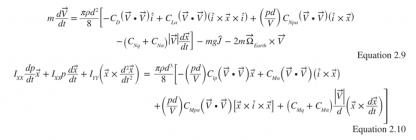So there are ballistic calculators in phones and scopes. What exactly are they doing and can you trust them?
The equations that predict how a bullet flies are pretty well understood and have been for about a hundred years now. They are:

These are actually six equations can be solved by a computer in what is called a six degree of freedom (6DOF) simulation. This type of simulation runs really slow (like 5-10 minutes to calculate the motion of a bullet out to 100 yards). We also have to know all of the little constants (aerodynamic coefficients) to get accurate results. Does anyone know what the Magnus coefficient of their bullet is?
We want to know where the bullet will hit! This is where ballistic modeling comes in. Real life is too complicated to completely model so we start approximating and simplifying. The simplest ballistic model is called the "ray theory". The bullet goes in a straight line until it hits something. This is actually really useful for pistols at short range.
What we have is a spectrum of models from the very simple to the really complex. You choose the model that is just complicated enough for the problem you are trying to solve.
The equations that predict how a bullet flies are pretty well understood and have been for about a hundred years now. They are:

These are actually six equations can be solved by a computer in what is called a six degree of freedom (6DOF) simulation. This type of simulation runs really slow (like 5-10 minutes to calculate the motion of a bullet out to 100 yards). We also have to know all of the little constants (aerodynamic coefficients) to get accurate results. Does anyone know what the Magnus coefficient of their bullet is?
We want to know where the bullet will hit! This is where ballistic modeling comes in. Real life is too complicated to completely model so we start approximating and simplifying. The simplest ballistic model is called the "ray theory". The bullet goes in a straight line until it hits something. This is actually really useful for pistols at short range.
What we have is a spectrum of models from the very simple to the really complex. You choose the model that is just complicated enough for the problem you are trying to solve.










